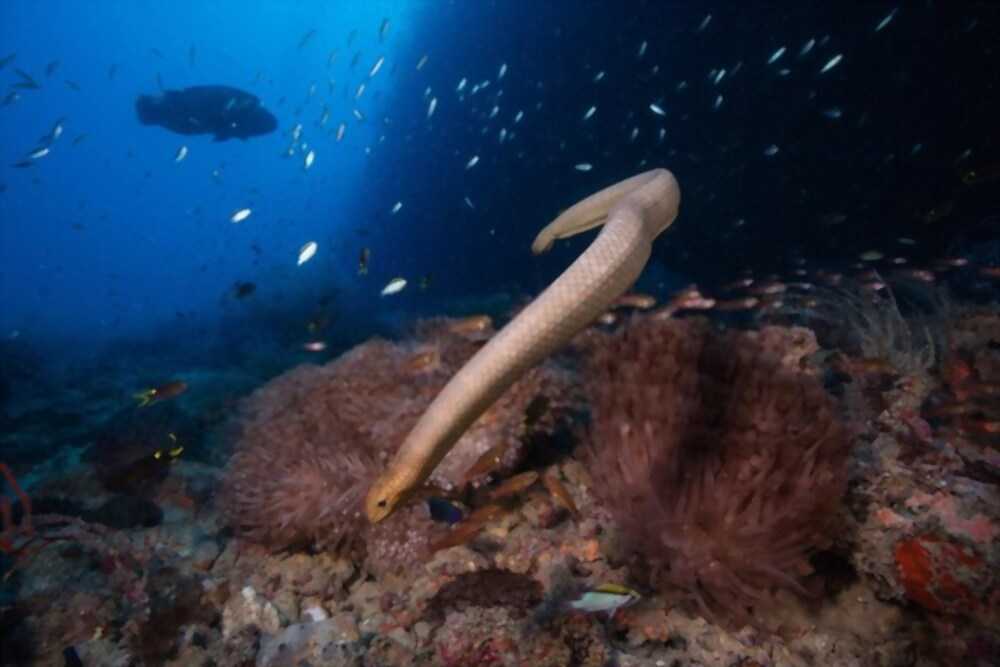The Corel Reef snakes are also known as Sea snakes. The coral reef snakes belong to the venomous snake family Elapidae. There are a total of 17 genera or subfamilies with more than 60 species of sea snakes.
The coral reef snakes belong to the Hydrophiinae genus or subfamily having 60 species. Most of the species of this genus are completely aquatic. The species of the genus Laticauda can also move on land. It has 5 species.
Habitat of the Coral Reef Snakes
The coral reef snakes are highly aquatic species that can not move on land. They like marine habitats, shallow water near lands, streams, rivers, and water around the islands. These species are mostly found in the warm tropical waters of the Indian Ocean, Pacific Ocean, and Oceania.
Physical Characteristics of the Coral Reef Snakes
The sea snakes or the coral reef snakes have the following main characteristics.
-
Size
The coral reef snakes are small to medium and slender species with length ranging from 3 to 5 feet. Some species with length up to 6.5 and even 9 feet have also been recorded in some rare cases. These species are very thin and skinny like a pencil.
These species weigh about 1.5 to 3 pounds.
-
Skin
The skin of the Coral Reef snakes is scaly and hard and it is used by the snakes for respiration inside the water. These imbricate scales protect the coral reef snakes from abrasion. These scales do not overlap. The skin has a striped or banded pattern throughout the body and does not break over the bellies.
-
Colors
The Coral Reef snakes are famous for their ringed or banded appearance. The coral reef snakes usually appear with bi-color, one base color, and the other band or stripe color. Their colors and patterns are one of their distinctive physical characteristics. They have dark bodies with black, dark brown, or dark grey colors with white or light grey stripes. the pattern of bands or stripes is in such asymmetry that it confuses for which one is the base color and which one is the band color.
-
Head and Neck
The head and neck of the coral reef snakes are of the same size. Both are narrow and flattened. They have a paddle-like tail that helps in swimming.
-
Fangs
The fangs of the coral reef snakes are small and weak. As the snakes have small head and mouth, they can not keep the fangs folded inside. Hence, the fangs remain outside the mouth and erected.
-
Venom
The Coral Reef snakes are known to have the second most dangerous venom. Their venom is highly toxic but they avoid injecting this venom to humans. This is because they have small fangs and less amount of venom which they want to keep safe for some other crucial time. This venom is mostly used to digest the food and for defense.
The bite of the coral reef snakes, however, can be very painful and must be treated immediately otherwise can be dangerous for life.
-
Life Span
The coral reef snakes can live a life of 7 years in captivity. Their life span in the wild is uncertain.
Species of the Coral Reef Snakes
Ther are more than 60 species of Coral Reef snakes. Some of them are as follows.
-
Yellow Sea Snakes
The Yellow sea snakes are the most common and brightest snakes of the coral reef species. Their scientific name is Hydrophis spiralis.
These species are the longest coral reef snakes with a length ranging from 8.5 to 9.8 feet. They have a yellow or yellowish-green dorsal body with pointed and rounded scales with black edging. The dark bands on their body are less than 1/3rd of the lighter interspaces.
Their heads are black for young and yellow for adults. Their tails are 4 to 5 inches long. these snakes are usually found in the muddy bottoms of seas and oceans.
-
Olive Sea Snakes
Olive sea snakes are also known as olive-brown sea snakes and golden sea snakes. Their scientific name which is used more than its real name is Aipysurus laevis.
The olive sea snake is different from other sea animals and species as it remains underwater all the time and does not go at the surface to breathe frequently. It has a big lung that helps it breathing for several hours without going at the surface. This species remains around the coral reefs at the bottom of the ocean throughout their lives.
The olive sea snakes are 4 to 5 feet long and have golden, olive, or purple-colored scales on the dorsal body with a white underside. They have photoreceptors in their tails that can detect light and help them hiding in the coral reef.
They can get aggressive when a human or large animal approaches near and can bite. This species is found in the Indo-Pacific.
-
Horned Sea Snake
Horned Sea snakes are one of the distinctive species of this family. They are also known as Peron’s sea snake, and the spiny-headed sea snake. Their scientific name is Hydrophis peronei.

The horned sea snakes are venomous and distinctive for being the only sea snake with spines on their heads.
These species are medium and have a length of 3 to 4 feet. They appear in tan, olive, and grey colors with dark bands. Their heads are small and their tails are flat. These snakes are mostly found in the sandy beds and coral reefs of the western tropical Pacific Ocean.
Behavior and Habits of The Coral Reef Snakes
The Coral Reef snakes are shy and reluctant species that avoid encountering humans and large animals. They possess a mild temper but can get aggressive when provoked. They feel awkward moving on the land. They can not coil or strike their prey like other terrestrial species.
The ocean or sea life is different from that of land or forests therefore, the coral reef snakes can be both nocturnal and diurnal. They are found active at any time of the day and night. In the late afternoons, they often come at the water surface to bask in the sunlight.
The coral reef snakes can live in the sea or ocean at a depth of 300 feet.
Feeding and Hunting of the Coral Reef Snakes
The coral reef snakes usually feed on small fish and fish eggs. They remain around the coral reef. Whenever a small fish passes nearby, they grab it with their tail and constrict it till it dies. These species do not use their venom to hunt. They use their venom to digest their prey as it contains protein-breaking enzymes.
Reproduction
All the species of this family are ovoviviparous except one genus Laticauda containing 5 oviparous species. The mating takes place in the water. The young ones are given birth in the water and spend their whole lives in the water. The eggs are laid on the land and they also hatch on the land. The offsprings often move into the water after hatching and start living in the sea. The young ones of this species are quite large, almost half the length of their mother.
What animals live in the coral reef?
The coral reef is a diverse ecosystem that includes a wide variety of animals, including fish, marine mammals, crustaceans, mollusks, and echinoderms. Some of the most common fish that can be found in the coral reef include clownfish, angelfish, damselfish, and parrotfish. In addition to fish, marine mammals such as dolphins and whales are also common in coral reefs. Other animals that can be found in coral reefs include sea urchins, starfish, sea cucumbers, and shrimp.
What do coral reef snakes eat?
Coral reef snakes eat mostly small fish, but they’ll also take crustaceans, mollusks and other invertebrates. They’re constrictors, so they coil around their prey and squeeze until it’s suffocated. Then the snake swallows its meal whole.
Are sea snakes real snakes?
Yes, sea snakes are real snakes. They evolved from terrestrial snakes that adapted to marine environments. Sea snakes have a number of adaptations that allow them to survive in the marine environment including swim bladders that allow them to stay afloat, salt glands that help them excrete salt, and fins that help them move through the water.
What kind of venom does a coral snake have?
Final Words
The Coral Reef snakes are beautiful creatures of nature. Their natural habitat is where they suit the most. This venomous species must not be brought home to keep as a pet. It can be dangerous as well as harmful to the snake’s life.







